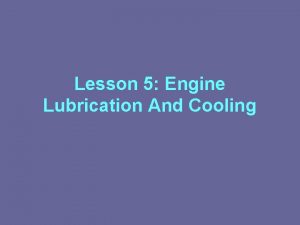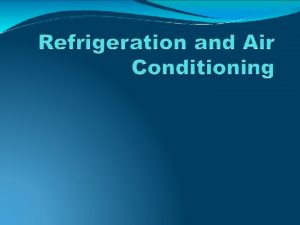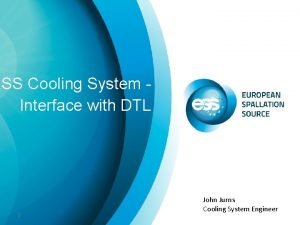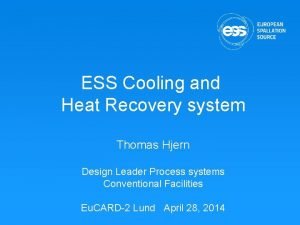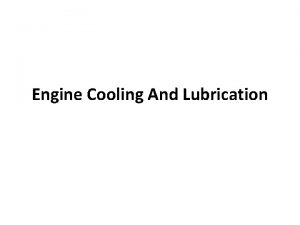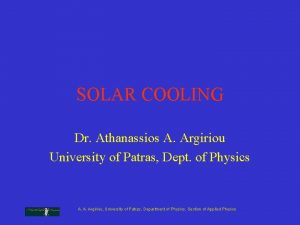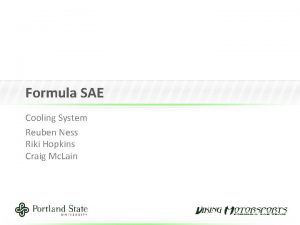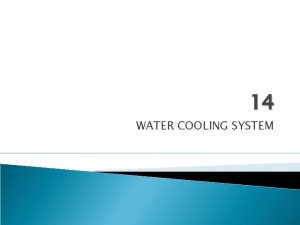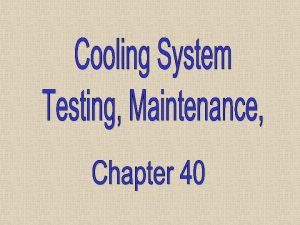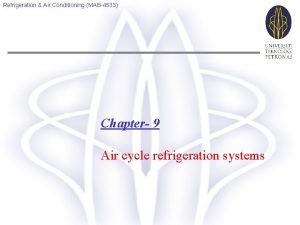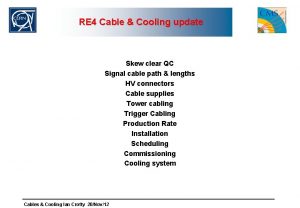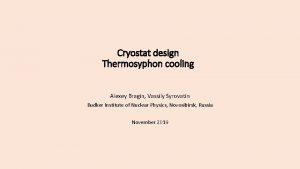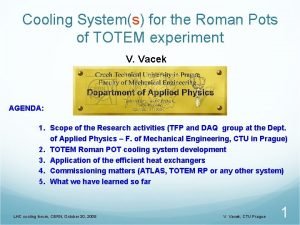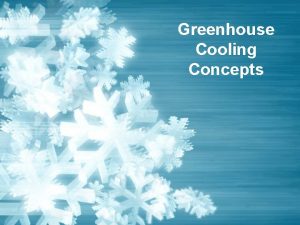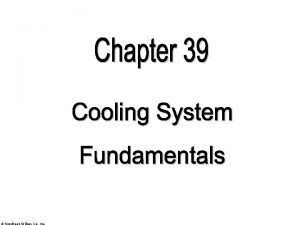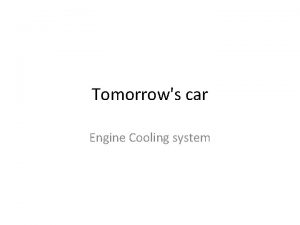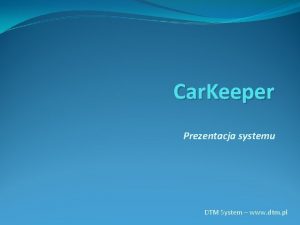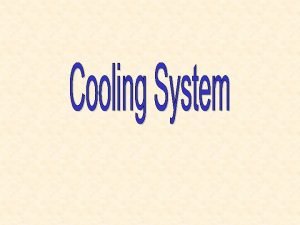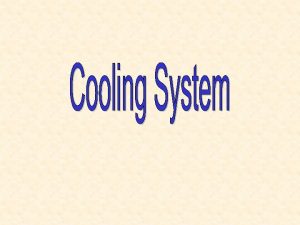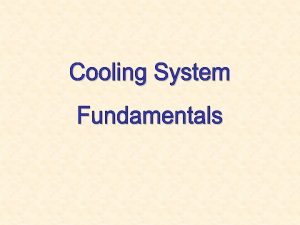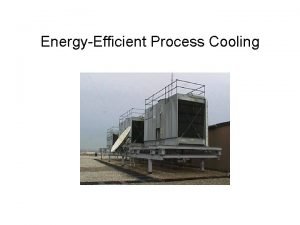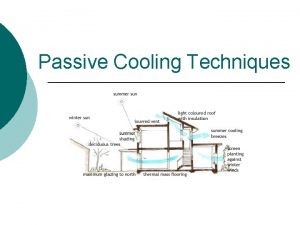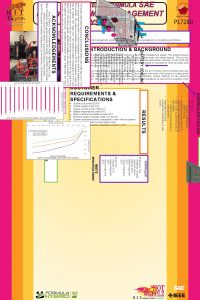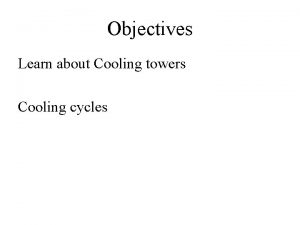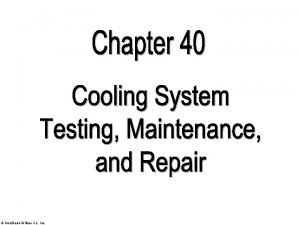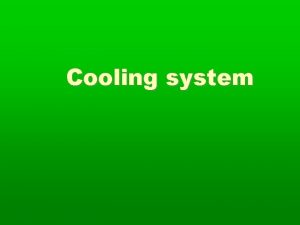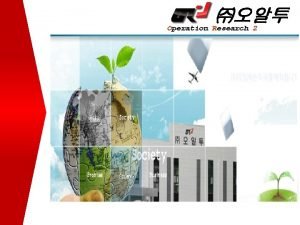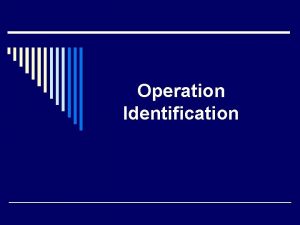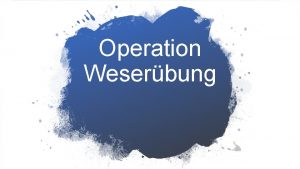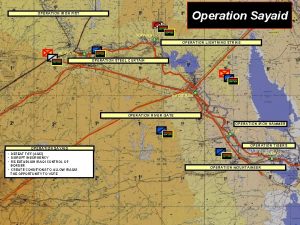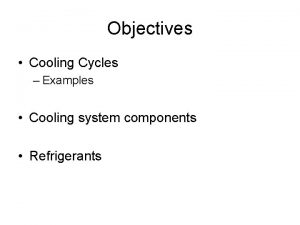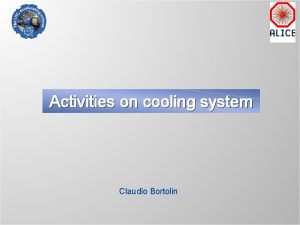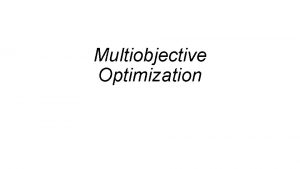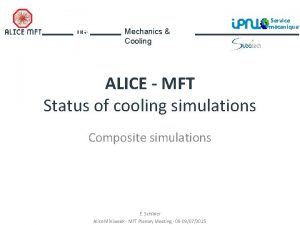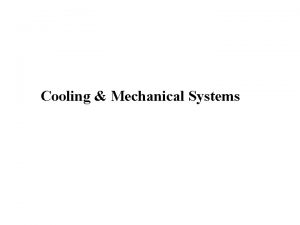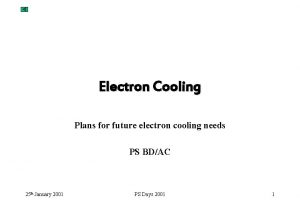Optimization of the Cooling System Operation for CCGTs



























































- Slides: 59

Optimization of the Cooling System Operation for CCGTs Marco Dieleman M&N Power Solutions Ltd. , Thailand Milton Venetos, Wyatt Enterprises LLC, USA Peter Pechtl, VTU Energy, Austria Josef Petek, VTU Energy, Austria

Summary of Analysis Study • Study and compare designs of cooling systems for CCGT plants • Various commercially available configurations implemented for a SGT 800 based plant at a site location in Thailand • For the each cooling system, a studies were run to quantify the average heat rate over the course of the year, for the assumed load dispatch and weather conditions. Once with all pumps and fans in operation, once with the number of fans/pumps optimized. • The study was performed using the EBSILON Professional heat and mass balance software

Cooling System Configurations Considered for the Study A year’s worth of hourly runs (8760 runs) were performed for each of the configurations. a. Mechanical Draft Cooling Tower + Water Cooled Condenser b. Air Cooled Condenser c. Air Cooled Condenser with Inlet Water Spray d. Heller System Dry Tower e. Heller System Dry Tower with Flue gas integration f. Heller System with Air Cooler

Cooling System Configurations Considered for the Study (continued) g. Heller System with Air Cooler + Standard water cooled condenser h. Hybrid Cooling Tower with 10, 30 and 50% of the steam going to the dry air cooled side i. Plume Abatement Tower with 15, 30 and 45% of the air going through the air cooler j. Natural Draft Cooling Tower k. Natural Draft Cooling Tower with Flue gas integration l. Cooling Pond The Ebsilon models use a base model that was derived from design information of a real plant, and for the analysis the operating conditions were modified for the cases that were studied

Performance runs used to evaluate Plant Performance The following runs were performed per configuration: • determine capacity at reference site conditions. This case was used to design/size the power plant. • determine fuel consumption, for an assumed yearly dispatch load profile, operating all pumps and fans. • to determine fuel consumption, for the same yearly dispatch load profile, but now with reduced number of pumps or fans, whenever this is more efficient. Using VTU Energy’s distributed calculations these 8760 runs can be processed in about 15 minutes (on 91 processors). A total of nearly 300 sets of 8760 runs were performed.

Load dispatch and weather forecasts used to evaluate Plant Performance The forecasted load profile for Thailand was based upon a typical daily load profile, super-imposed on a monthly profile, both based upon historical data. An hourly weather profile was based upon historical data.

Assumptions for the cooling systems For this study, we assumed the following: • 3 C approach (either to condenser saturation temperature, wet bulb temperature, dry bulb temperature) • 2 x 50% pumps were used at reference site conditions, either 1 or 2 pumps were in operation throughout the year. • 3 mechanical draft fans were used at reference site conditions, either 1, 2 or 3 fans were in operation throughout the year. • Cycles of Concentration: 4

Overall plant simulation model

Overall plant simulation model • 2 x 1 combined cycle plant • SGT 800 gas turbine • No inlet air conditioning • 2 Pressure Level Unfired Cycle • Horizontal HRSG configuration • Process Steam Export, assumed at a maximum of 40 tonm/hour • Different Cooling Systems

Heat balance model of the Cooling System (Mechanical Draft Cooling Tower)

Heat balance model of the Cooling System (Air Cooled Condenser)

Heat balance model of the Cooling System (Air Cooled Condenser with Spray)

Heat balance model of the Cooling System (Heller System – Dry Tower)

Heat balance model of the Cooling System (Heller System – Dry Tower with Flue Gas )

Heat balance model of the Cooling System (Heller System - Air Cooler)

Heat balance model of the Cooling System (Heller System – Regular Condenser + Air Cooler)

Heat balance model of the Cooling System (Hybrid Cooling Tower – ACC + Cond/Mech. Draft CTW)

Heat balance model of the Cooling System (Natural Draft Cooling Tower)

Heat balance model of the Cooling System (Natural Draft Cooling Tower – With Flue Gas)

Heat balance model of the Cooling System (Cooling Pond)

Heat balance model of the Zero Liquid Discharge – Brine Concentrator + Crystallizer

Key design parameters of the base model Variable Design parameters for the different cooling systems: • Vary design condenser pressure between 80, 100 and 120 mbar • Vary Air to Water ratio between 0. 6, 0. 8 and 1. 0

Comparison of overall plant performance for the various cases at RSC (optimized for design condenser pressure and design air to water ratio)

Comparison of overall plant performance for the various cases, averaged over the year (optimized for design condenser pressure and design air to water ratio)

Comparison of overall plant performance for the various cases, averaged over the year (optimized for design condenser pressure and design air to water ratio)

Impact of adding ZLD on overall plant performance for various cases (optimized for design condenser pressure and design air to water ratio)

Water Consumption and Drain (optimized for design condenser pressure and design air to water ratio)

Impact of design condenser pressure and air to water ratio on Heat Rate Mech. Draft Cooling Tower with ZLD Air Cooled Condenser

Impact of design condenser pressure and air to water ratio on Water Makeup and Drain Mech. Draft Cooling Tower - Makeup Mech. Draft Cooling Tower + ZLD - Makeup Air Cooled Condenser

Impact of design condenser pressure on Heat Rate Air Cooled Condenser with Spray ACC with Spray and with ZLD Heller Dry Tower

Impact of design condenser pressure on Water Makeup and Drain Air Cooled Condenser with Spray - Makeup Air Cooled Condenser with Spray + ZLD - Makeup

Impact of design condenser pressure on Heat Rate Heller System with Air Cooler Hybrid Cooling Tower-30% ACC with ZLD

Impact of design condenser pressure on Water Makeup and Drain Heller System with Air Cooler Hybrid Cooling Tower-30% ACC - Drain Hybrid Cooling Tower-30% ACC - Makeup

Impact of design condenser pressure on Heat Rate Heller System with Air Cooler and Standard Cond. Plume Abatement CTW-15% AC with ZLD

Impact of design condenser pressure on Water Makeup and Drain Heller System with Air Cooler and Standard Cond Plume Abatement CTW-15% AC - Drain Plume Abatement CTW-15% AC - Makeup Plume Abatement CTW-15% AC+ ZLD - Makeup

Impact of design condenser pressure on Heat Rate Plume Abatement CTW-45% AC with ZLD Pond

Impact of design condenser pressure on Water Makeup and Drain Plume Abatement CTW-45% AC - Makeup Plume Abatement CTW-45% AC + ZLD - Makeup

Impact of design condenser pressure on Heat Rate Natural Draft Cooling Tower with ZLD

Impact of design condenser pressure on Water Makeup and Drain Natural Draft Cooling Tower with ZLD

Heat Rate vs Drain Flow (all units on) Average Yearly Heat Rate vs Drain Flow (all units on) 8100 8050 Net Heat Rate k. J/k. Wh 8000 7950 7900 7850 7800 7750 7700 0 1 2 3 4 5 Drain Flow (to cooling sytem) kg/s 6 7 8

Heat Rate vs Makeup Flow (all units on) Average Yearly Heat Rate vs Makep Flow (all units on) 8100 8050 Net Heat Rate k. J/k. Wh 8000 7950 7900 7850 7800 7750 7700 0 5 10 15 20 Makeup Flow (to cooling sytem) kg/s 25 30 35

Heat Rate vs Drain Flow (units optimized) Heat Rate vs Drain Flow (optimized) 8150 8050 Net Heat Rate k. J/k. Wh 7950 7850 7750 7650 7550 0 1 2 3 4 5 Drain Flow (from cooling system) kg/s 6 7 8

Heat Rate vs Makeup Flow (units optimized) Heat Rate vs Makeup (optimized) 8150 8050 Net Heat Rate k. J/k. Wh 7950 7850 7750 7650 7550 0 5 10 15 20 Makeup Flow (to cooling system) kg/s 25 30 35

Selection of Optimal Off-design configuration per hour for various design conditions Mechanical Draft Cooling Tower (3 Fans, 2 Pumps)

Selection of Optimal Off-design configuration per hour for various design conditions Air Cooled Condenser (3 Fans)

Selection of Optimal Off-design configuration per hour for various design conditions Air Cooled Condenser with Inlet Air Spray (3 Fans, Spray on/off)

Selection of Optimal Off-design configuration per hour for various design conditions Dry Heller Tower (2 Pumps)

Selection of Optimal Off-design configuration per hour for various design conditions Heller with Air Cooler (3 Fans)

Selection of Optimal Off-design configuration per hour for various design conditions Heller with Standard Condenser and Air Cooler (3 Fans)

Selection of Optimal Off-design configuration per hour for various design conditions Hybrid with Standard Condenser/CTW (3 Fans/2 Pumps) and Air Cooled Condenser (3 Fans)

Selection of Optimal Off-design configuration per hour for various design conditions Hybrid with Standard Condenser/CTW (3 Fans/2 Pumps) and Air Cooled Condenser (3 Fans)

Selection of Optimal Off-design configuration per hour for various design conditions Plume Abatement with Standard Condenser/CTW (3 Fans/2 Pumps) - 15% Air to Air Cooler

Selection of Optimal Off-design configuration per hour for various design conditions Plume Abatement with Standard Condenser/CTW (3 Fans/2 Pumps) – 45% Air to Air Cooler

Selection of Optimal Off-design configuration per hour for various design conditions Natural Draft Cooling Tower (2 Pumps)

Conclusions • Highest capacity at RSC: Natural draft CT. • Best yearly average heat rate (all pumps/fans in operation): Natural Draft Cooling Tower. • Best configuration using optimal number of pumps/fans: Natural Draft CT. • Best dry/ZLD configuration, at RSC: Heller Dry tower • Best dry/ZLD configuration using all fans/pumps: Heller Dry tower • Best dry/ZLD confguration using optimal number of pumps/fans: Natural Draft CT with ZLD & Heller Dry Tower • Best possible improvement of heat rate when optimizing pumps/fans operation: 0. 6155 % for the Air cooled Condenser with Inlet Air Spray option

Conclusions (continued) • Minimum improvement of heat rate when optimizing pumps: 0. 21% for the natural draft cooling tower • The optimal design pressure is a clear function of the configuration • The optimal heat rate over the year and the optimal capacity are not necessarily at the same design pressure • If simply turning fans/pumps equipment on/off, then a variable speed drive for the fans or variable speed pumps would be able to provide even more benefits

Conclusions (continued) • Further optimization parameters are: AWR ratio (this was only tested at several intervals), pinch point (currently 3 C), design pressure, (this was only tested at several intervals) • Given the large variation in loads and temperatures, an entire year's worth of part load points is required to provide narrow down the accurate design options, as was done in this study. • Regardless of the configuration or design pressure or air to water ratio, part load optimization of either pump of fan operation will almost always be beneficial for heat rate.

Conclusions (continued) • Flue gas added to Heller or Natural draft tower, does not add much to the performance, but it reduces the tower design height for the same performance. • Accurate weather projections and dispatch profiles will have to be known, to estimate the fuel savings which can be achieved.

Questions? In case of questions, don’t hesitate to contact the author at: marco@mandnpower. com
 Engine lubrication and cooling system
Engine lubrication and cooling system Simple air cooling system
Simple air cooling system Ess cooling system
Ess cooling system Ess cooling system
Ess cooling system Splash lubrication system
Splash lubrication system Solar cooling system
Solar cooling system Fsae cooling system
Fsae cooling system Jacket water cooling system treatment
Jacket water cooling system treatment Mshowup
Mshowup Actual air refrigeration system
Actual air refrigeration system Closet cooling system
Closet cooling system Plasticavi
Plasticavi Thermosyphon cooling system design
Thermosyphon cooling system design Roman cooling system
Roman cooling system Convection tube cooling in greenhouse
Convection tube cooling in greenhouse Engine cooling system
Engine cooling system Smart car cooling system
Smart car cooling system Dtm cooling system
Dtm cooling system Fspos
Fspos Typiska novell drag
Typiska novell drag Nationell inriktning för artificiell intelligens
Nationell inriktning för artificiell intelligens Returpilarna
Returpilarna Varför kallas perioden 1918-1939 för mellankrigstiden
Varför kallas perioden 1918-1939 för mellankrigstiden En lathund för arbete med kontinuitetshantering
En lathund för arbete med kontinuitetshantering Adressändring ideell förening
Adressändring ideell förening Tidbok
Tidbok Sura för anatom
Sura för anatom Vad är densitet
Vad är densitet Datorkunskap för nybörjare
Datorkunskap för nybörjare Boverket ka
Boverket ka Mall för debattartikel
Mall för debattartikel Magnetsjukhus
Magnetsjukhus Nyckelkompetenser för livslångt lärande
Nyckelkompetenser för livslångt lärande Påbyggnader för flakfordon
Påbyggnader för flakfordon Lufttryck formel
Lufttryck formel Svenskt ramverk för digital samverkan
Svenskt ramverk för digital samverkan I gullregnens månad
I gullregnens månad Presentera för publik crossboss
Presentera för publik crossboss Vad är ett minoritetsspråk
Vad är ett minoritetsspråk Plats för toran ark
Plats för toran ark Klassificeringsstruktur för kommunala verksamheter
Klassificeringsstruktur för kommunala verksamheter Luftstrupen för medicinare
Luftstrupen för medicinare Claes martinsson
Claes martinsson Cks
Cks Programskede byggprocessen
Programskede byggprocessen Mat för unga idrottare
Mat för unga idrottare Verktyg för automatisering av utbetalningar
Verktyg för automatisering av utbetalningar Rutin för avvikelsehantering
Rutin för avvikelsehantering Smärtskolan kunskap för livet
Smärtskolan kunskap för livet Ministerstyre för och nackdelar
Ministerstyre för och nackdelar Tack för att ni har lyssnat
Tack för att ni har lyssnat Hur ser ett referat ut
Hur ser ett referat ut Redogör för vad psykologi är
Redogör för vad psykologi är Borstål, egenskaper
Borstål, egenskaper Tack för att ni har lyssnat
Tack för att ni har lyssnat Borra hål för knoppar
Borra hål för knoppar Vilken grundregel finns det för tronföljden i sverige?
Vilken grundregel finns det för tronföljden i sverige? Formel för standardavvikelse
Formel för standardavvikelse Tack för att ni har lyssnat
Tack för att ni har lyssnat Steg för steg rita
Steg för steg rita
